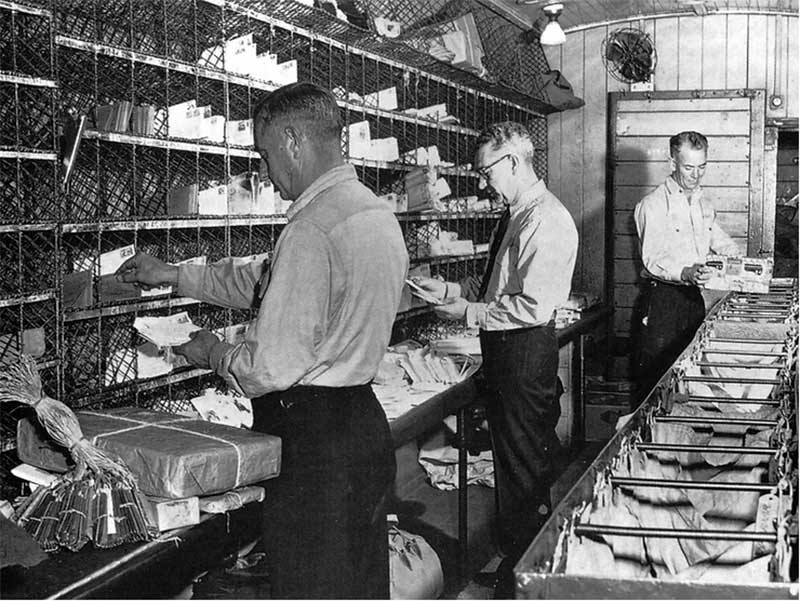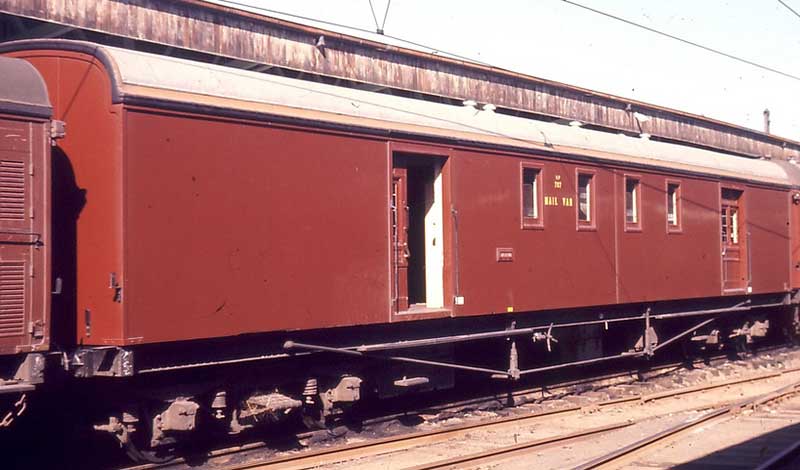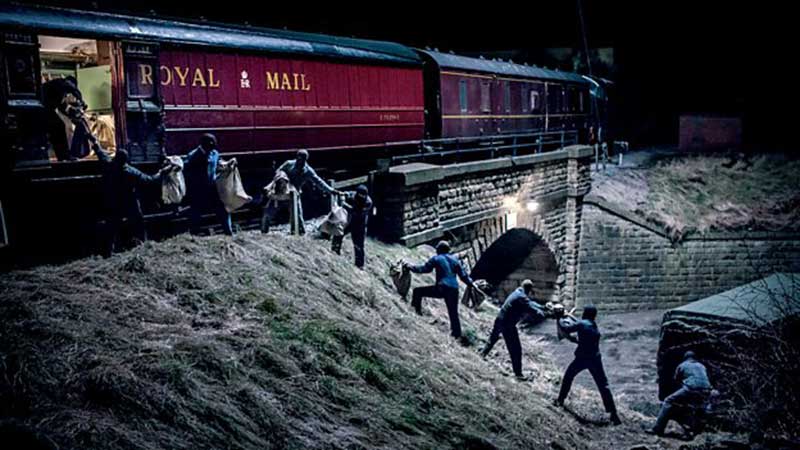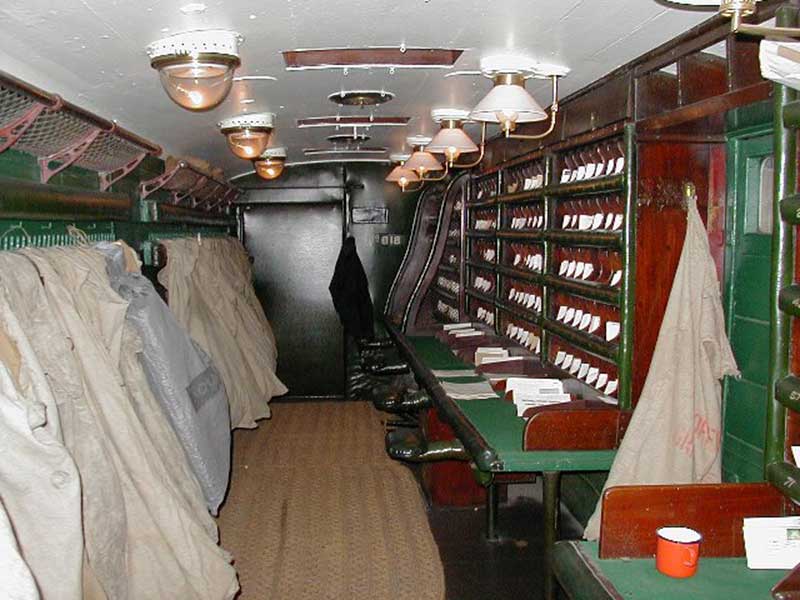
Postal officers sorting mail in a KP van. Photo: NSW Railway Archives
During the 19th and early 20th centuries, railways provided a fast and reliable means of carrying the mail. The opening of a new line usually meant transferring the carriage of mail to rail, instead of by coach or ship, to ensure the mail arrived sooner and at more predictable times.
The rail link opened between Wodonga Vic. and Albury NSW in 1883 allowed mail to be carried between Melbourne and Sydney in a day, compared to a week long journey by coach in earlier years. Also, railways offered greater security against robbery, particularly for registered mail (which usually contained valuables), compared to coach journeys.
The importance of railways to postal services was reflected in a common practice of locating post offices at railway stations in smaller towns. The duties of stationmaster and postmaster were often combined to facilitate the handling of mail. With the General Post Offices of Sydney and Melbourne being located in the central city area, their mail exchange buildings adjoined the central railway stations for more efficient mail handling.
A special feature of “mail by rail” was the Travelling Post Office (TPO). TPO services comprised dedicated railway carriages specially outfitted for mail to be sorted and postmarked during the journey. TPOs were introduced to Victoria as early as 1865 and the innovation was soon adopted by the other Australian colonies. Most TPOs were phased out by World War II, although some that linked isolated areas continued operating until more recent years. Australia’s last TPO in northern New South Wales ceased in 1985. A video, Australia Post – The Last of the TPOs, was produced to mark the closure of the last remaining TPO service in Australia.
The Trans-Australian Railway operated a “pay train”, which commenced service in 1915 (during construction of the railway), and continued operating until 1986. The pay train provided stamp sales, money orders and banking facilities for railway employees working along the line. The actual post office was situated in the middle of one carriage, with a public area of about two metres long and one metre wide, and a foothold to reach the counter when the pay train was not operating at a station.
Railways were important for carrying domestic mail, but they also provided the vital link for overseas mail. Until 1917, Adelaide was the “first and last” port-of-call for most of Australia’s overseas shipping links. From Adelaide, passengers, freight and mail could be transported more quickly by rail to Melbourne, Sydney, Brisbane and elsewhere in eastern Australia. The Adelaide-Melbourne express train provided the key for the efficient handling of the inwards and outwards overseas mail. On some occasions, it was even necessary to arrange dedicated trains solely to carry the mail between Melbourne and Adelaide.
With the opening of the Trans-Australian Railway in 1917, Fremantle replaced Adelaide as the “first and last” port-of-call and, as a result, reduced the time required to transmit overseas mail within Australia.
The “mail by rail” era came to an end in the mid-1980s. The carriage of non-standard letters and parcels by railways was replaced by a fleet of trucks acquired by Australia Post to carry this mail between capital cities and regional centres. However “mail by rail” has returned in recent years. Australia Post has returned to using rail to carry mail between Adelaide and Perth. This has reduced its total annual greenhouse emissions by 2.5 per cent.

Photo: SDS Models
Eleven of these 63'4" vans were built by Ritchie Bros. for NSw Government Railways in 1912. Originally finished with tongue and groove siding doors they were all rebuilt in the early 1960s with plywood sides. These vans carried four postal workers who sorted late mail for destinations along the route. In the 1960s, the KP mail vans were regularly used on the North Coast Mail, the North West Mail, the South West Mail and the Through Mail. These trains left Central up to 6 days per week. In the 1970s the destination of some services changed, however mail sorting services still operated to the major inland centers of Grafton, Werris Creek, Glen Innes, Orange and Junee/Albury. The last KP in use was on The North Coast Mail in 1985.

Re-enactmemt of the Great Train Bobbery, as depicted in the BBC One television drama, The Great Train Robbery
The most notorious incident in railway history involving a travelling post office is what became known as The Great Train Robbery in which £2.6 million was stolen from a Royal Mail train heading from Glasgow to London on the West Coast Main Line in the early hours of 8 August 1963 at Bridego Railway Bridge, Ledburn, near Mentmore in Buckinghamshire, England.
With careful planning based on inside information, a gang of 15 men pulled of the heist. The bulk of the stolen money (equivalent to £58 million or over $Aus100 million today) was never recovered. By tampering with the lineside signals, they were able to bring the train to a halt, and exceute the theft.

Post Office Van O18 was originally built as Post Office Van O18 for use on the Intercolonial Express that ran nightly between Adelaide and Melbourne. It was jointly owned by the Victorian and South Australian Railways, and was first used in January 1887.
When new Post Office vans were constructed for the Express in 1908 it become the exclusive property of the South Australian Railways who renumbered it 258. Having little use for a mail van, it was converted in 1916 to Officers Inspection car Murray. When the new Commissioner’s car was named Murray in 1934, the old Murray was given the name Willochra, a name that had previously been used on, at that time, a recently condemned sleeping car.
After being condemned in 1966, it was used for accommodation on a farm at Jabuk and eventually ended up at Old Tailem Town Historic Village, in Tailem Bend. In June 1991 it was moved to the National Railway Museum at Port Adelaide, where it is on display.
Design by W3layouts